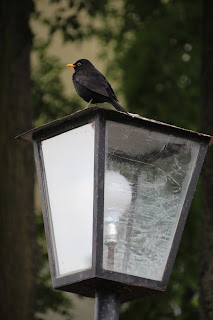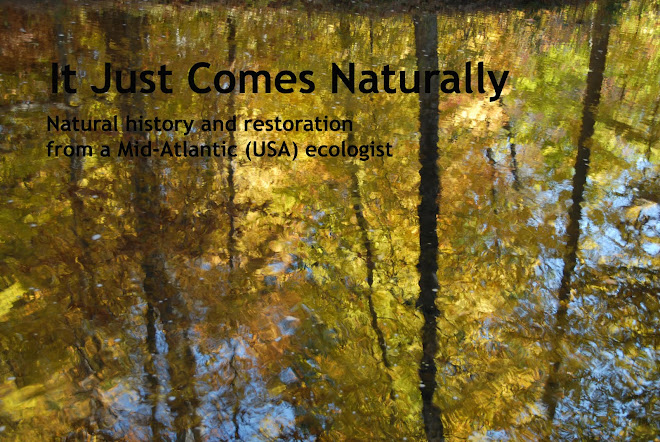One hundred forty years ago, an intense corporate rivalry inadvertently produced the largest wetland in my county, located just a quarter-mile south of my preserve. In the mid-1870s, the Pennsylvania Railroad and Reading Railroad each were desperate to build a railroad linking Philadelphia to New York City. The Pennsylvania Railroad chose a route that was slightly longer but which incorporated a straightaway that ran level and flat for dozens of miles along an old geological fault. The Reading Railroad selected a shorter, more direct route that used the water gap eroded by my creek to penetrate the high, steep northern face of the geologic fault. Each railroad company had to place tremendous quantities of fill in the wide floodplain of my creek in order to raise its tracks out of the floodplain, and this fill, in turn, impeded drainage toward the creek, thereby impounding the 40-acre wetland with which we are blessed today.
 |
| Field trip participants on the former Reading Railroad bridge over the swamp drainage channel |
Because the wetland includes habitat that is unusual in southeastern Pennsylvania, the Philadelphia Botanic Club scheduled a field trip to visit the site on Saturday morning, June 6, and they asked me to come along for the walk. Though I have walked in the wetland proper a few times, I usually stick to the railroad tracks when I explore. The Reading Railroad tracks have been removed and are now part of a county rail-trail (about which I have posted before); the Pennsylvania Railroad tracks are still in use for commuter rail service.
 |
| Making our way down from the railroad bed to the marsh |
The water in the wetland is deepest near the rail lines, then the land gradually slopes upward and becomes drier as the distance from the tracks increases. Nearest the tracks, the wetland is a marsh with dense emergent herbaceous vegetation. Further uphill, the vegetation grades to shrub-swamp. And, in the driest areas, the wetland becomes a red maple-pin oak (Acer rubrum-Quercus palustris) swamp forest. Our group of seven walkers at first scoped-out the wetland from the elevated railroad tracks, and then skidded down the embankment and "took the plunge" into the jungle led by yours truly, who got tired of just poking around the edge. Fortunately (for the hike), we hadn't had much rain lately, so the wetland had little standing water and just a few inches of organic ooze.
 |
| Let the botanizing begin! |
Almost immediately, we came across a pair of Eastern Box Turtles (Terrapene carolina carolina) in flagrante delicto; alas, they disengaged immediately.
 |
| The female half of an Easter Box Turtle pair |
Further into the marsh, we found a nest likely built by Red-winged Blackbirds (Agelaius phoeniceus) last summer suspended between a few twigs .
 |
| Last year's nest, probably from a Red-winged Blackbird |
 |
| An abundance of sedges (very challenging to identify) |
 |
| Field trip leader Joe serving as a backdrop for pictures of a blooming sedge |
One of the plants we were especially interested in finding was lizard's-tail (Saururus cernuus). It's not that rare, but it's an interesting wetland obligate that's not extraordinarily common. I was the first to come across the plant and squealed with delight at my discovery. Then, as we continued across the marsh, we found huge expanses of the plant.
 |
| Our quarry: Lizard's-tail (Saururus cernuus) |
 |
| One of my favorite plants: parasitic dodder (Cuscuta spp.) (the orange "silly string") How cool is that? |
We finally emerged from the marsh and shrub-swamp into the drier swamp forest. Here, there's no understory to impede walking because the large deer herd that finds refuge in this isolated pocket of wilderness eats most regenerating trees and shrubs.
 |
| Pin oak-red maple swamp forest in the driest parts of the swamp |
I wasn't enthusiastic about participating in this walk. It was on a Saturday morning after I had just worked a full week, and it involved a trudge through mud and extremely dense vegetation (think African Queen here). But, you know what? I had a great time! I got wet and muddy and the company was simpatico. When I got back home and told Kali about my morning, she said, "Despite your belly-aching, I knew you'd have a great time!" She knows me better than I know myself.
_____
A note to my blogging colleagues and readers: Kali and I were on vacation at the end of May (blog post to appear soon), and I have been crazy busy since we got back. I apologize for not having commented or posted recently.



























